
My dog, Bear, is a 6-year-old chocolate labrador retriever.
In his puppy days, he was in good health. This was until I blindly trusted our old conventional veterinarian. I didn’t know a fraction of what I know now back then, and I allowed him to triple-vax Bear in one day. Bear experienced an anaphylactic reaction which set off a whole host of issues…namely, a cataract, allergies, anxiety/restlessness, and ulcerative colitis. This was when he was maybe 4-5 months old.
Despite the ophthalmologist and our vet telling me that it would be impossible (and that there was a 90% chance Bear would need surgery + an 80% chance of retinal/detachment glaucoma post-surgery), I reversed his cataract naturally after doing a deep dive on the internet. I overhauled his diet (switched to raw) and did a series of eye drops religiously for a couple of months. As far as I know, he has retained 80-90%+ vision in that eye and we have had no further issues with the eye to date.
After the caratact, Bear experienced a series of episodes that we later learned were due to ulcerative colitis. I sought out help from a holistic vet who explained that if Bear had been on a kibble diet the entire time, he may not have been alive. To get the UC under control, we did a round of antibiotics. This was the last time I gave him conventional medication.
I have spent the most recent years restoring his health naturally.
In this post, I share our journey from start to present, beginning with the vaccine reaction that sent him into anaphylactic shock. I also talk about:
- how we reversed his cataract naturally
- the ulcerative colitis episodes and what we did to resolve them
- how adopting a “less is more” attitude helped Bear’s health
- a skin infection that (seemed to) almost kill him and how I treated it with homeopathy and herbs
- Advanced Allergy Therapeutics testing and treatment for dogs
- a natural alternative for removing skin cancer (we’re trying it as we speak instead of surgery)
- mineral testing for animals and Bear’s custom plan
- what Bear currently eats and the supplements I give him

Where the dis-ease began
Note: If you’d like to skip to the natural products I currently give Bear to support his health, scroll down to “August 2023 Update.”
Bear was in perfect health until he wasn’t.
I still kick myself for getting him vaccinated. That’s where this all started. I didn’t understand the dangers of vaccination at the time, and if I could do it over, I would either do no vaccines or maybe just the parvo vaccine.
Bear went into anaphylactic shock about 45 minutes after the Parvo-Leptospirosis-Bordetella trio at just a few months old.
His entire body swelled and was covered in hives.

We rushed him back to our vet. Thankfully with some prompt medical intervention, he made it. But a few months later, we started to notice that something was wrong with his left eye. It was a different color than his right eye when shining a light on it.
We took him to our vet and he recommended we see an ophthalmologist.
We made an appointment with the opthalmologist for a couple of weeks out.
Before our appointment, we noticed his left eye (the affected eye) swelled and he could barely keep it open. He was also pawing at it.
This made me feel uneasy and I couldn’t sit with the uneasiness. I was extremely anxious at the time (in general), and since I didn’t know what was going on with that eye, we decided to take him to the emergency vet.
I don’t even know what happened there since I was pretty numb. They asked for our permission to do some procedure where they would need to sedate him to look into his eye.
We agreed, so they did it.
They found nothing. We left with no answers, a huge bill, and a puppy that appeared to be yelping/crying in distress (throughout the entire night) as the sedative wore off.
Soon after, we went to our ophthalmologist appointment and were met with a somber diagnosis: Bear had a cataract. At just 6 months old.
We were told he would likely need expensive surgery (upwards of $5K+), and post-surgery, he would have nearly an 80% risk of developing glaucoma or retinal detachment. In either case, he could lose his eye completely. This was not reversible, according to the doctor. She said it would only get worse with time, and likely fast.
Naturally reversing the cataract
I went home and cried. Once the tears were out, it was time to get to work.
I became manic and dove headfirst into research. I knew there had to be a natural route to fix this. I had reversed ailments that I was told could not be healed or reversed using natural methods in the past, and I knew there had to be a way here.
After days with my head buried in blue light, I came up with something.
I developed a 5-drop 3x per day regimen coupled with supplementation and a diet change. We followed it religiously for two months, and decided to forego the medication the doctor prescribed him because the side effects of it were, can you believe it, cataracts!
We attended our follow-up visit with our ophthalmologist after the two-month regimen. She turned the bright lights off, the red light on, and pulled out her eye-viewing tool. She shined the light in his left eye. There was a long period of silence – enough to make me think something was up. Either my plan had worked, or it had not worked at all.
“I’m confused,” she said, “not only has the cataract not progressed, it looks like it improved. I’ve never seen this happen before.”

She was in disbelief, and I held my head up a bit higher that day.
If you are interested in the story, I shared a video on YouTube about it.
The remedy works for dogs and humans. If using it for a human, I noted which products you should not use below.
Here is the remedy:
Drop #1 – Flax oil
Drop #2 – Liquid MSM
Drop #3 – Can-C
Drop #4 – Cineraria maritima
Drop #5 – Ocluvet (omit this if using this remedy for a human)
- Administer 1 drop of each product directly into the eye. One cycle = all five products (five total drops).
- Wait 10-15 minutes in between each drop, if possible. If you don’t have this much time, try to wait at least a few minutes in between each drop so each one can absorb into the eye.
- Repeat the cycle 3x per day. I recommend morning, afternoon, and evening, if possible.
Additional supplements:
Antioxidant treats*
Cataractin
Plant enzymes & probiotics
Omega 3’s*
(omit these supplements if using this remedy for a human)
When we started the drops, we also stopped feeding Bear kibble and switched him over to a raw diet. We started out with Steve’s Real Food and eventually switched over to The Farmer’s Dog.
Bear’s left eye remains clear of nearly all of the cataract. There is still some residue, but not much. He retains about 95% vision in the eye consistently.
*Note: I’m not sure if any of the “additional supplements” were necessary for healing. Possibly the Omega 3’s. Another good source of Omega 3’s is Safe Sea by Four Leaf Rover. I think the drops and the raw diet were large contributing factors to Bear’s healing. Also, I would not recommend the antioxidant treats knowing what I know now. They’re processed.
You may be wondering…does one have to do the drops forever?
Maybe. I did the drops on Bear initially for about a year. I started out with three cycles per day for the first two months, decreased to two cycles per day after that, and eventually one cycle per day. After about a year, I stopped completely.
He had a few check-ups with the vet during this time and the cataract always kept its status (nearly gone with slight remnants) for about three years.
At a check-up a few years back, the vet mentioned it had worsened a little. I had started to notice it again myself at that time too, so I started the drops back up again. I did three of them once per day for maintenance.
After starting the drops again, the cataract began to look better and better. And after a few months, I didn’t notice it anymore. I haven’t received professional confirmation, but visually, it looks great and I am confident the drops are working.
If you decide to try this remedy yourself, I suggest going full force and blasting the eye. Do it three times per day if you can and see what happens. If things improve and are going well, you can back off a bit and try to maintain with less.
Chronic disease is a slow-moving decay. This means you also experience a slow heal. An ailment like a cataract is not usually an emergency, so there is time to figure out what works best for your situation. To this day (nearly 6 years later), I still give Bear Cineraria Maritima daily, and sometimes Ocluvet.
The drops will likely be something I need to do for the rest of his life, but it’s a very small price to pay for him to retain two well-seeing eyes.
Bloody jam poop
Once the dust settled post-cataract, I felt like I could breathe a little.
This was right around the time I was diving into my own personal healing. I was learning a lot and unpacking what it means to be healthy, but I was still very much in the beginning stages of the journey for both myself and Bear.
I wasn’t nearly as intuitive and observant when it came to paying attention to Bear’s body language (or my own, for that matter) and gauging it for signs of wellness or dis-ease.
Things were still very much black and white in my mind, at this time. “Healthy” or “not healthy.” “Right” or “wrong.”
I was less mindful and more logical.
As a result, I started mindlessly throwing lots of “healthy” stuff at Bear.
Two-ingredient treats (say, sweet potato and chicken) without looking into sourcing. Coconut oil. Goat milk. Tons of different veggies and fruits. Turmeric. Bone broth. Eggs.
If my research determined it fell into the “healthy” bucket, it could do no wrong.
And if I was only giving Bear “healthy” things, all was good. I had a “the more, the better” approach.
We lived this way for a while, and once again, Bear was fine until he wasn’t.
He began to have these episodes where he would sit against the wall and appear uncomfortable.
When he did that, we took him outside. He would pace quickly to a nearby park where he would usually poop. Sometimes it was diarrhea. Sometimes he would strain and nothing would come out.
When he had these episodes, he would sit against the wall every 3o minutes. We’d take him out multiple times per day, sometimes as much as 10-15 times per day and/or throughout the night.
I’m a bit embarrassed to admit that for a long time, I never intervened. He just had these episodes.
One would happen, time would elapse and I would sort of forget about them, then another would happen seemingly “out of the blue.” I was always uneasy when it was happening, but I guess I just never thought to do anything other than endure the episodes. Or maybe I didn’t know what to do at the time.
Fast forward to the episode that changed it all…
I noticed that Bear had specks of blood in his poop. This concerned me, so I did a Google search. I discovered that goat milk could be good for digestion.
I went to the pet store, found some raw goat milk, and gave it to Bear.
He drank it just fine, but immediately hurled it all up. I had never seen him throw up so violently. His body clearly did not want it.
He seemed uneasy so I took him outside in our backyard.
He paced nervously and ended up pooping in the corner…a huge pile of what looked like bright red jam.
This was a frightening sight. It literally looked like he pooped a pile of bloody brains.

This is not Bear’s poop, but his poop looked something like this
In a panic, I did some online research. I found a few different remedies and thought, “maybe he just needs that” or “maybe this herb will help” or “maybe the goat milk is making him detox and he just needs time.”
I also found very unsettling things about dogs pooping blood which made me wonder if I was in an emergency situation.
As I was cycling through the options, something told me to just stop and get help. Don’t add anything else. Don’t try anything else. Just get help…from an expert I at least somewhat trusted (I was quite skeptical of providers at the time, and still am).
I searched for a holistic vet. At the time, there were two in California and one in our area. I sought out help from the one in our area.
He diagnosed Bear with ulcerative colitis (UC). He also mentioned that without the dietary interventions we had made thus far (raw/homecooked food + no processed treats), Bear may not have been alive. He specifically mentioned kibble…that he may not be alive if we had kept him on a kibble diet.
He suggested putting Bear on Tylan, which according to him, was a gentle antibiotic. This would allegedly help the ulcerative colitis (sounds strange, but the way he explained it made sense). Then after a few weeks of use, the UC would clear up, then we’d continue to replenish Bear’s body with good food and other natural things.
We followed his plan. I’m not sure if the Tylan worked or not, but the UC did clear up. The holistic vet also mentioned that a straight raw, meat-only diet may be a bit harsh for Bear’s healing gut and that he may need some fiber.
He suggested squash, green beans, spinach, berries, and a few other fruits and vegetables. He also recommended probiotics, digestive enzymes, and rotating protein sources.
At that point, I was just giving Bear beef from The Farmer’s Dog and had never heard about rotating protein sources.
So I diversified his diet. I think we added turkey and maybe pork into the meat rotation along with some pureed fruits and vegetables. I’m pretty sure I gave him probiotics and digestive enzymes too, although I can’t remember for sure.
He seemed to do okay with this…I think. I don’t remember observing him closely at that time, as I mentioned before.
But he was no longer pooping blood or having those wall-sitting episodes, and I was thrilled about that.

Something still not quite right
While Bear’s condition was stable in the poop department, there were a few things that still didn’t seem quite right.
He was pretty itchy and also anxious/restless at times.
As I mentioned before, I was diving deep into my own health. So optimizing and detoxifying everything around me (including Bear’s health and diet) became my job. I became obsessed, really.
I looked deeper into what we were feeding him – the Farmer’s Dog, at the time – and didn’t like that their formulations included legumes and other plants. I also researched raw diets and the raw philosophy made sense to me.
We got Bear tested for food sensitivities too. I’m not sure how accurate those tests are, but I felt like it was a good box to check.
We decided to ditch The Farmer’s Dog and do a build-your-own raw diet.
At the time, we were living in the Bay Area, CA, and we came across a local store, SF Raw. It’s like a candy shop for raw feeders!

They have tons of different protein sources, meat cuts, organs of all kinds, supplements, health blends, one-ingredient treats…and all are consciously sourced. The pork refrigerator is pictured above, for example. If you’re located in the Bay Area, I highly recommend checking them out. Viva Raw is another great brand that ships to multiple states. We buy duck from them.
I still had my “the more, the better” approach, so I went to town and built Bear a hefty raw diet.
Here are some resources if you’d like to learn more about how to build a raw diet:
- Make Raw Feeding Simple
- Raw Diet For Dogs: 6 Steps To Get Started
- 9 Tips For Starting Your Puppy On A Raw Diet
- Switch Your Dog’s Diet From Kibble To Raw
We tried beef, turkey, rabbit, sardines, quail eggs, duck eggs, and many other things. Plus tons of different animal organs.
Overall, Bear was doing better, but he would still have random symptoms that seemed to pop up out of nowhere.
He randomly regurgitated his food, for example. He’d eat the food right after regurgitating it (which is common for wolves/dogs), but the regurgitation itself was unsettling and seemed like it was happening too frequently. Sometimes he’d have loose stools or would strain with no stool, and other times he seemed constipated. His endurance was low at times, especially in the heat. He also had yeasty ears, on and off bad breath (which is not normal for dogs), and would itch a lot.
I gave him Quercitin (“Nature’s Benadryl, as they say) for his itching one day. That didn’t go well. This is Amazon review I left for the product I tried…

And crazy enough, another dog owner tried that exact same product for the same reason and the exact same thing happened to his dog. He saw my review after-the-fact and found me on Instagram to share. So I would definitely not recommend that product (or maybe Quercitin at all) if you’re trying to quell allergies/itching in your dog.
I put Bear on some probiotics and he seemed to get worse – itchier, restless, and if I remember correctly, he also regurgitated more.
During one of our SF Raw shopping trips, I spoke with one of the owners, Casey (she’s great), at length about what was going on with Bear. She gently reminded me of the “less is more” concept.
During that conversation with her, I had an “a ha” moment. I realized I had been mindlessly “drowning” Bear with a million things and not paying attention. I was shooting in the dark, frantically, in hopes that something would land. This could have been hurting him more than it was helping. In fact, it probably was.
So I decided on a few protein sources (I can’t remember which ones – I think it was rabbit, turkey, and beef) and decided to give him only meat for a few months.
No supplements, no treats, no extras. Just a 80/10/10 raw blend (80%/10%/10% = muscle meat/bones/organs).
This was harder than it sounds. I found myself constantly wanting to intervene and add something else…a supplement, a treat, something.
But I didn’t, and his body regulated. In fact, to this day, he is at his healthiest when I give him only meat and nothing else.
The infection that (seemed to) almost kill him
We moved to Austin, Texas in December 2020.
Bear was doing pretty good. He still had random symptoms here and there, but nothing too dramatic.
I was giving him his meat blend plus a few fruits.
I was always told that you should either:
- rotate a dog’s protein source every quarter or so
- feed 3-4 different protein sources at the same time
I did the latter. I usually fed him some combo of rabbit, beef, duck, turkey, and venison.
I noticed he did better with certain proteins. He had less itching/symptoms plus more energy when I focused on certain proteins and/or withheld others.
He always did so great with beef. At times, my gut told me to feed him only beef, but the “I need to give him 3-4 protein sources” stuck with me so I never did.
I also had a hunch that rabbit and venison weren’t great for him and that his body wanted duck. I was never really sure about turkey.
He had always done horribly (he became extremely itchy) with any type of fish. I tried giving him salmon, white fish, and sardines and all caused increased itching, so I stayed away from fish.
He had a few UC flare-ups the first few months we were in Austin. He was back and forth between constipation and diarrhea and occasionally had a little bit of blood in his poop.
So I added a little bit of slippery elm to his food during flare-ups and that appeared to help his bowels.
At this time, I wasn’t conscious about what fruits and vegetables were good (or not good) for him, so I shot in the dark with that, just like with protein sources. I had hunches but didn’t dial it down at that time.
I decided to do another round of meat only. And like always, he improved greatly. He had tons of energy and barely any symptoms.
A couple months into the meat-only phase, I intervened with my “more” energy, once again.
Whenever Bear has a long period of doing well, I second-guess myself. I convince myself that I am not giving him everything he needs.
It sounds strange, but he always does the best on meat only, so when he’s doing well, it is usually because he is only eating meat.
And when he is only eating meat for a long period of time, I begin to worry that his diet is lacking in some critical nutrient.
This is probably due to conditioning from the dog food companies. (They spend lots of money brainwashing you into thinking dog food is “perfectly formulated” and if you deviate from their “perfect” food, your dog will suffer.)
When I am in this period of second-guessing myself, I usually end up diving into raw diet research and making these huge supplement plans for Bear for both vitamin/mineral consumption and preventative health.
During this particular round of research, I decided to start him on:
- Green tripe (supposed to be good for gut health)
- Hip & Joint (hip & joint health)
- Green Rover (liver support)
- Immunity Mushrooms (immune support/cancer prevention)
- Safe Sea (for omega 3’s)
- Plus I continued on with the slippery elm intermittently
In my mind, it goes something like…
“Phew, things are steady and going well. The path is clear. Now it’s time to optimize Bear even more and think about his future health.”
Then I add stuff in again.
During this round, I’m still not sure what happened. I’m not sure if the influx of new supplements weakened his immune system, or maybe it wasn’t that at all and what happened would have happened anyway.
Right around the time I introduced all of the above supplements, we took Bear to a local dog park with a manmade watering hole weekly. This was in the summer of 2021.
This is another thing I’m embarrassed to admit…that we even allowed him to swim in the water there. The water is dirty, untreated, and hundreds of different dogs swim in it weekly.
I heard about how dogs got sick from that park with parasites and other illnesses. There is even a sign in front of the water at the park now (it wasn’t there at the time of the incident) that says “UNTREATED WATER. ENTER AT YOUR OWN RISK.”
We took Bear to this park several weeks in a row without any issues. He absolutely loves the water/swimming, so even with the stories I heard, I didn’t think anything of it at the time since he was…once again…fine until he wasn’t.
One day, I noticed what appeared to be a little scab on the top of his head. I assumed it was a cut or something from dog park play. It was about 1/4 of the size of what you see in the below picture when I first noticed it, and I didn’t think anything of it.

Over the coming days, it got bigger and bigger. Soon, this thing began to spread and eat away at his head.

I am not exaggerating when I say this. At the peak of this infection (or whatever it was), nearly half of his head/face was covered in pus-filled scabs that would ooze and weep all day. The below pictures show the progression.
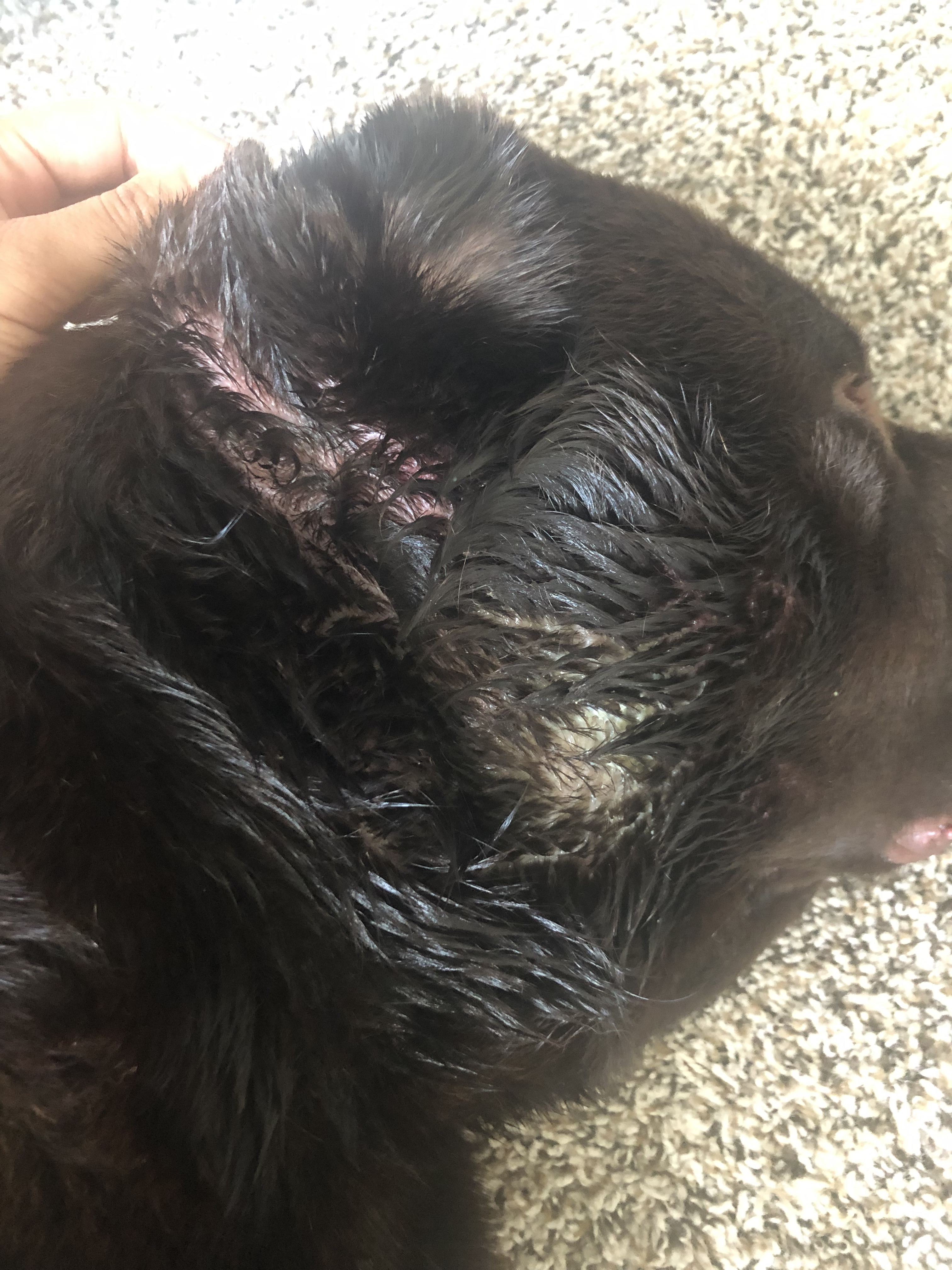
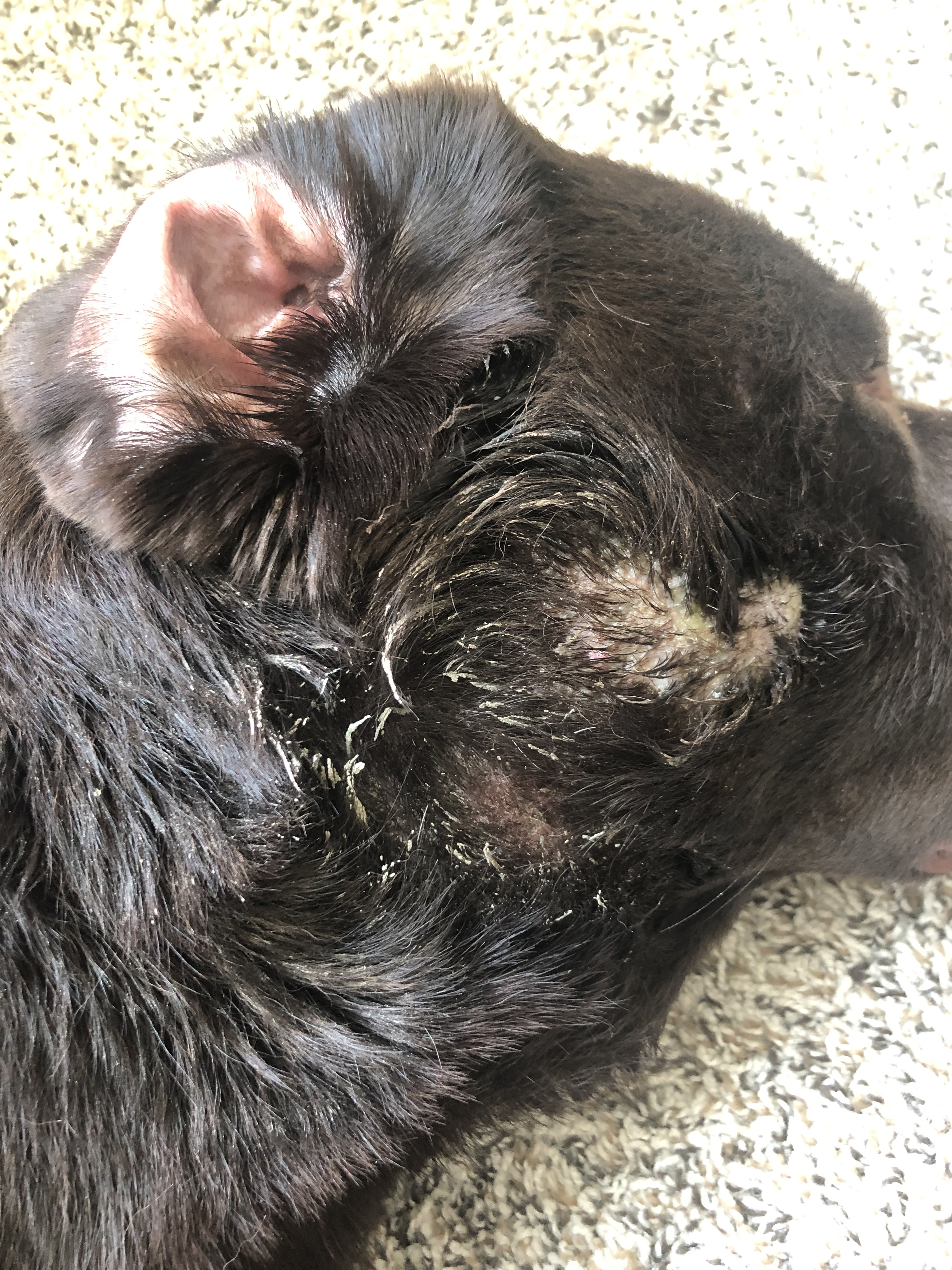

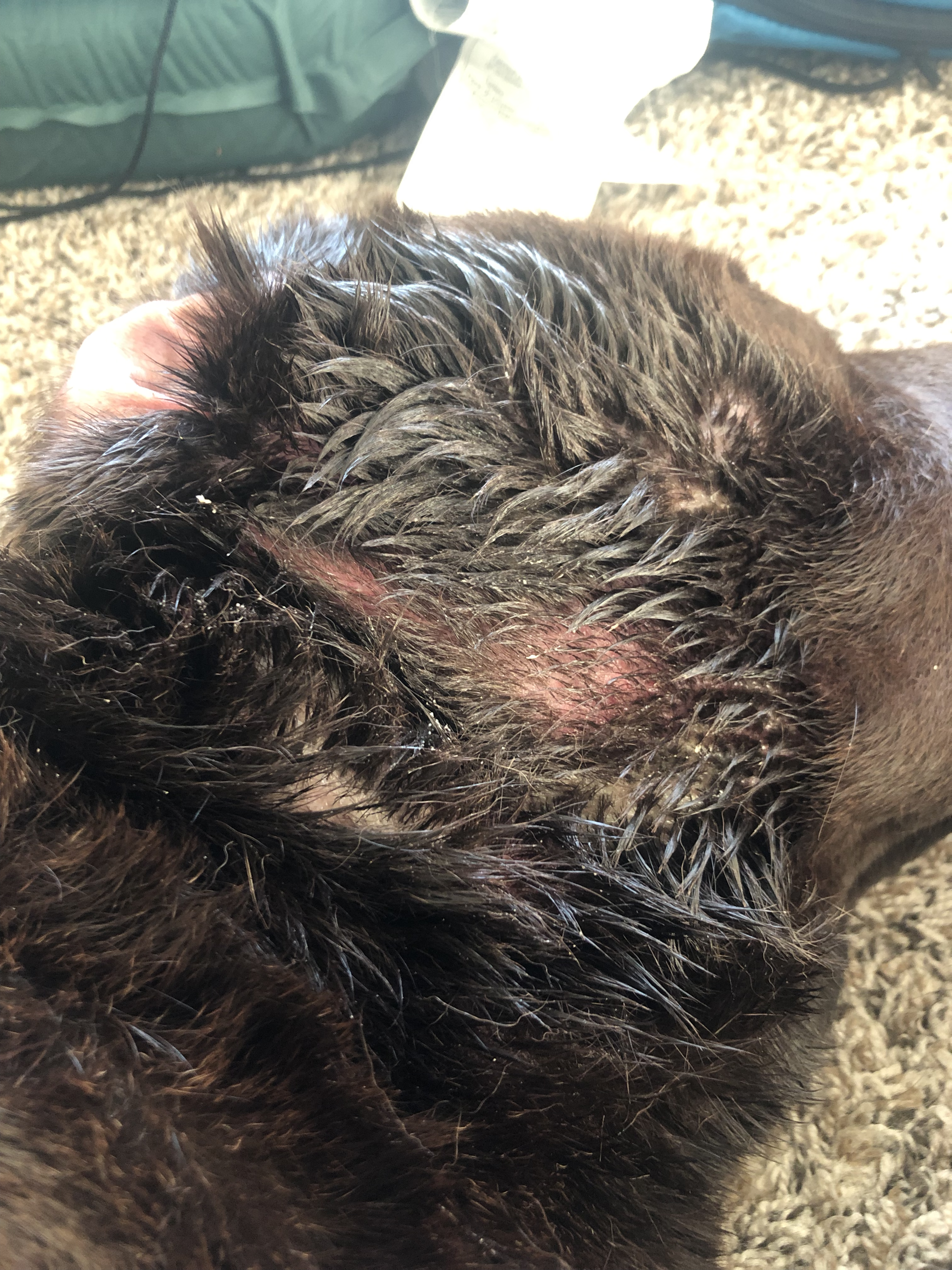

The last photo in the above sequence is when he finally started to heal.
I assume it was a bacterial infection he caught from the watering hole.
During the height of the infection period which was about 4-5 days, his body was hot to the touch and he had labored breathing. His ears were bright red and his restlessness was very high. The only way he would calm is if I would lay with him and pet him, but even that didn’t always work. He just wanted to pace and/or sit against the wall. I had never seen him that miserable.
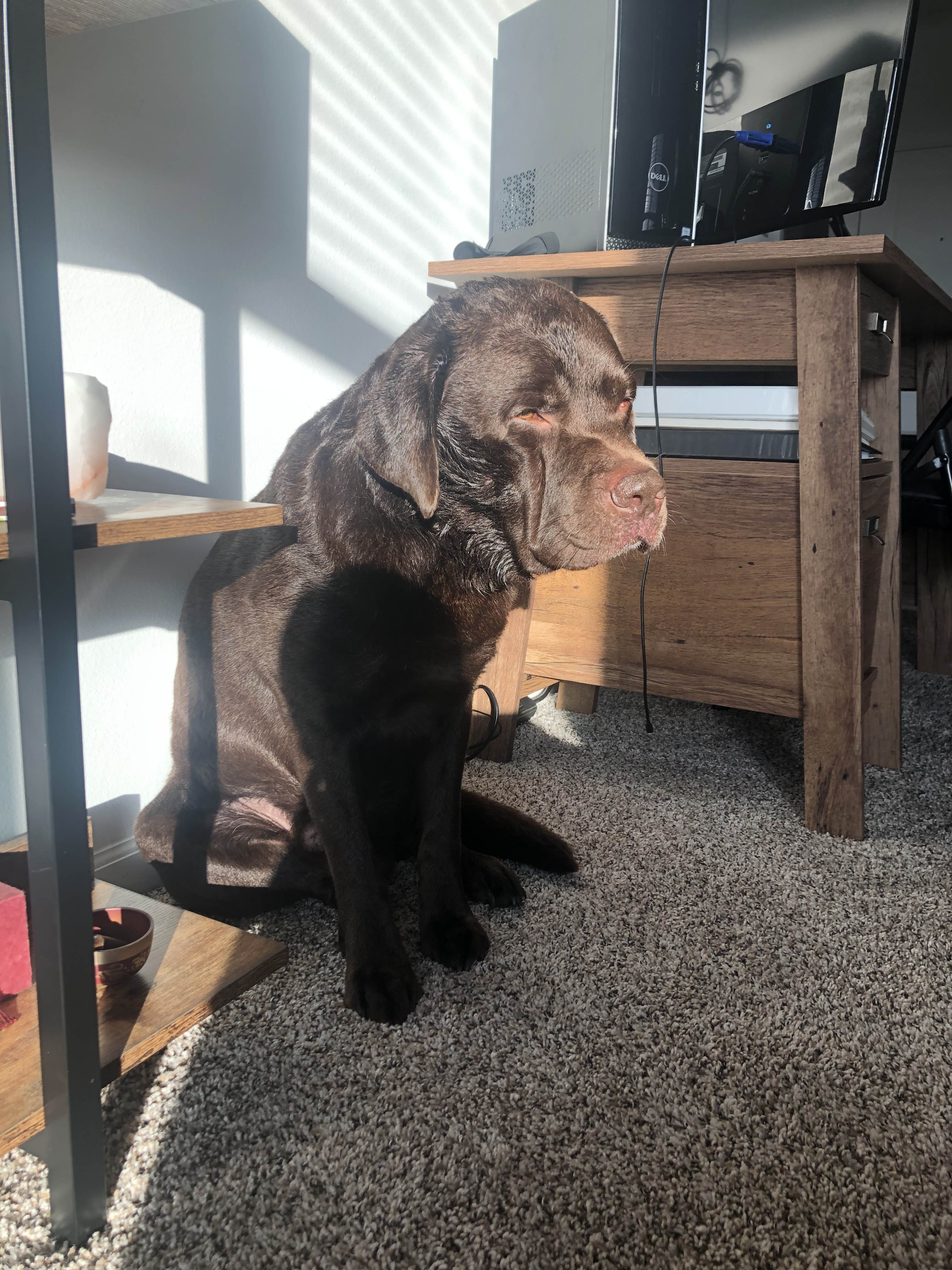
I don’t think I slept for 2-3 days when we were in the thick of it. He required round-the-clock care. This illness pushed the limits of my knowledge, patience, and faith.
I hit a challenging place that felt close to my edge and wondered if I would regret not seeking help.
Despite it getting very bad, I stuck it out and treated it at home.
I didn’t want to rock his gut/body even further with antibiotics/pharmaceuticals. And I figured that once he came out of it, his immune system would be so strong having made it through something this intense naturally.
I almost can’t believe it, but he recovered fully with zero physical remnants of the infection. His skin restored and all of his hair grew back.
Below is a picture of Bear that was taken in February 2023 (the day I am writing this post). The shot shows the side of his head that was affected by the infection.

This is what I used to support his body in clearing the infection:
- Bentonite clay (in the early stages in attempt to dry out the wounds)
- Diluted apple cider vinegar (in the early stages in attempt to kill the bacteria)
- Belladonna
- Aconitum napellus
- Homeopet Hot Spots (Graphites, Hepar sulph, Rhus tox, Sulphur)
- Chlorhexidine shampoo (the only exception to “natural”; was desperate and did a few washes, not sure if it helped)
- Herbal blend from my local farmers market (applied once the wounds began to heal)
I used most of these things all at once, so I’m not exactly sure what worked. I did notice a turning point when I introduced the homeopathic remedies on day 2-3, however…particularly the Belladonna and Homeopet Hot Spots.
Allergy testing
When the dust settled after that monster of an experience, I, once again, was able to take a deep breath.
I felt like it was time to find a vet in Austin.
Supporting Bear’s body naturally and trusting it to heal, then seeing it actually heal, gave me a surge of confidence.
I figured I’d probably do most things myself moving forward, but hoped to find a partner that I could rely on in case I ever needed help.
(This is always my goal, but it has been very challenging to find a vet that aligns with my philosophy on healing.)
I found a guy online that looked promising. He did acupuncture amongst other things.
I called him and spoke with him at length. He didn’t have any upcoming availability, but he gave me a ton of information.
He mentioned that venison/turkey probably weren’t good protein sources for Bear (due to their energetic heat) and that cooling/neutral proteins could be good, like beef, rabbit, and duck.
He also said that Bear shouldn’t be eating cold food.
So I stopped giving Bear venison and stuck with beef and turkey. I kept turkey in the rotation because I still had the “you need to serve 3-4 protein sources” idea in my head. I would have loved to give him duck, but a rabbit/duck blend was the only thing available to us at the time. I had a hunch Bear didn’t do well with rabbit, so I avoided the blend.
I was left with beef and turkey.
I didn’t take the cold food thing seriously and continued to feed Bear his food straight out of the refrigerator.

Meal prep day
I continued my vet search and found another place. Their website looked good and I liked their philosophy.
They offered chiropractic, acupuncture, and allergy testing and appeared to have a holistic approach.
I booked an appointment with the allergist for a wellness check-up. I planned to eventually do allergy testing, so I figured it would be a good idea for the allergist to be our primary doctor.
At the first appointment, we aligned on most fronts, which was great. We disagreed on a few things (namely, heartworm prevention) but that was fine.
The vet was also pretty firm about Bear not eating cold food, and that the cold food could be contributing to the regurgitation. This was the second time someone told me this (aside from the million and one times my husband did also), so I began to take it seriously, but still didn’t at times. I guess I still wasn’t convinced, for whatever reason.
About a year later, we saw the same vet for Advanced Allergy Therapeutics (AAT).
I still don’t fully understand the AAT method, but the doctor hooked Bear up to a machine and the machine sent signals to his body. Each signal was based on a certain frequency that matched a potential allergen (food, environmental, etc.).
The doctor also held a device in her hand. The way the device swung (or not) determined if Bear was allergic to the substance.
The technique is identical to NAET/muscle testing for humans.
Here are Bear’s results from the AAT testing…
“+” = allergic
“-” = not allergic
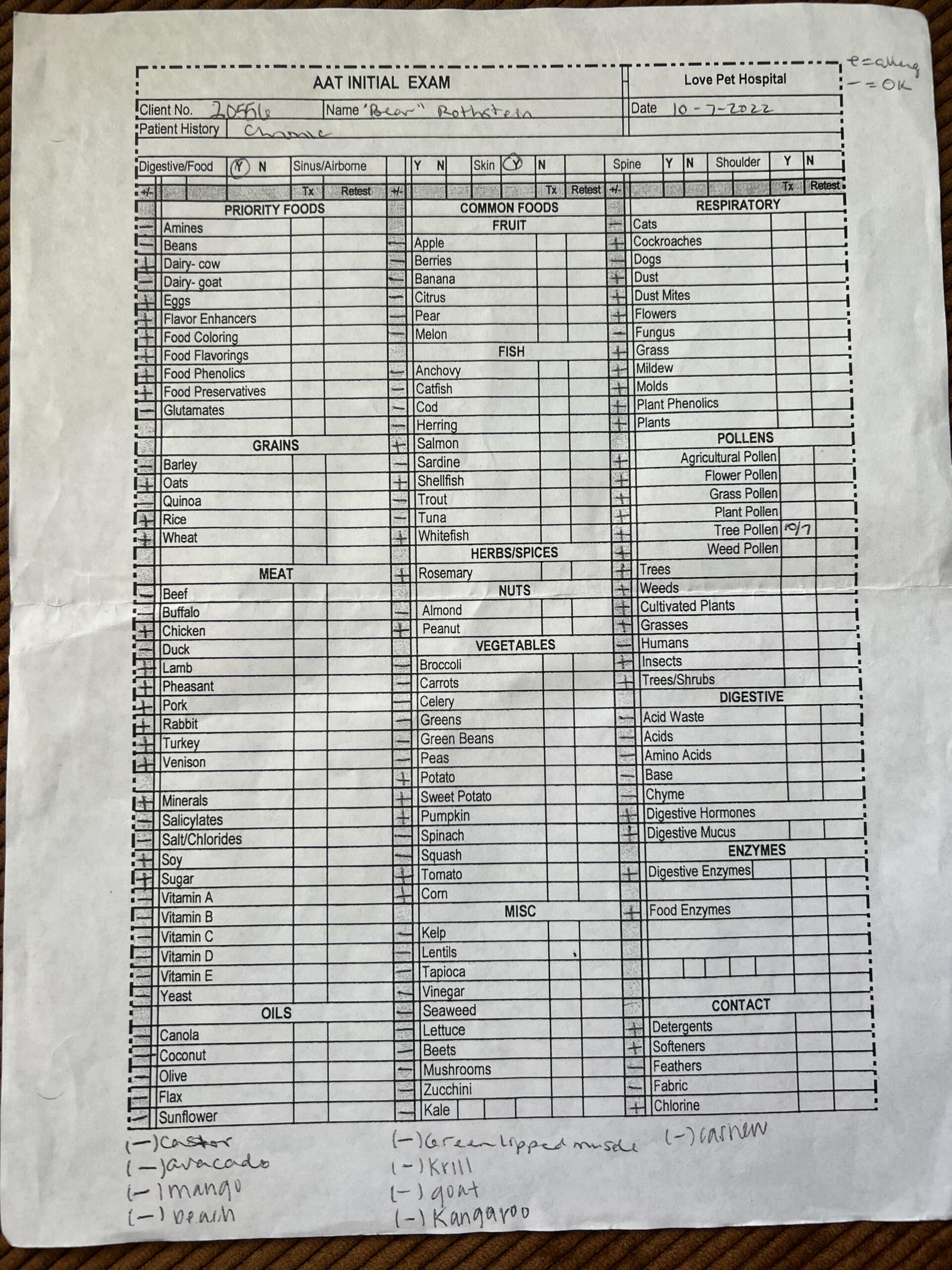
The only protein sources he is not allergic to are beef, duck, and bison. This confirmed my intuition, which fascinated me.
I had also given him squash a few weeks prior to the test. A few days after giving him the squash, he had his first UC flare-up (bloody poop) in over a year. So it was interesting to see squash show up as an allergen.
With the way that AAT works, the system determines which allergen is a top priority that day, and that’s the one you treat.
Treatment is completed by sending frequencies via the machine to the body, then hitting certain acupuncture points. The idea is to remove the link between the allergen and stress, thus “clearing” the association from the body.
According to the AAT philosophy, you can treat up to two allergens per day.
So the first day, tree pollen showed up as the top priority, so we treated that.
As for the food allergens, if you plan to eliminate them from the diet, there is no need to do treatment on those. So that’s what I decided to do.
After the appointment, Bear was super relaxed and noticeably less itchy, which intrigued me.
I booked a few more allergy treatment appointments in the coming months along with another wellness check since he was due for one.
With the new allergy knowledge, I sought out a source for duck (and found one), kept Bear on beef, and eliminated turkey. S0 I fed him beef and duck (meat only) plus a few supplements:
- HWF (natural heartworm preventative)
- Cineraria maritima (cataract maintenance)
- Ocluvet (cataract maintenance)
There are a few supplements that I gave Bear intermittently.
- Immunity Mushrooms (immune support/cancer prevention)
- Turkey tail mushrooms (immune support/cancer prevention)
- Safe Sea (omega 3’s)
- Ozonated hemp oil (for oral health)
- CBD (for immune support/inflammation)
He didn’t usually do well with the “intermittent” supplements long-term, but one day here or there was fine. He’d sometimes itch a bit more, but other times he’d have no reaction.
Bear still eats beef and duck (meat only) to this day.
I also switched Bear over to a healthier animal-based shampoo since the previous one we were using had oatmeal (which showed up as an allergen on the AAT test).
Note: I don’t only use Perma Earth shampoo bars for Bear. They transformed my hair too! Read more about that here, if interested.
The growth
At Bear’s wellness visit the prior year (2021), he had three lumps:
- one black one on his muzzle (looks like a mole)
- one black one on his side (looks like a small black mark)
- one under the skin on his back
Our vet was not concerned about the one under the skin as she thought it was a cyst. She also wasn’t concerned about the black one on his side as it was not raised.
She was concerned about the black one on his muzzle since it was slightly raised. She said it was too small to aspirate, so we should just watch it to see if it changes.
Fast forward to his most recent wellness visit (December 2022)…
We did a full blood panel (thyroid, kidney, and liver function + white/red blood cell + heartworm + tickborne illness), a fecal test for parasites, and all other physical checks (heart, lungs, paws, balls, etc.). Everything looked good.
The only exception was his ears. They were a bit yeasty and red. I ended up treating them at home with:
- Apple cider vinegar
- Coconut oil
- Homeopet Hot Spots (internally)
- Ear cleaner (I used this one + a medicated one – also from Amazon, but can’t find it now – since the right ear was stubborn and wouldn’t budge for weeks)
Back to the appointment…
We revisited the lumps.
The black mole on his muzzle that our vet was concerned about last time hadn’t changed, which was good.
We aspirated the one under the skin and it turned out to be a cyst, as she thought, which was also good.
And the flat black mole that she initially wasn’t concerned about actually disappeared…also great.
However, a few weeks prior, I noticed a black growth in between his “toes” on one paw. It looked like a wart at first glance. Aside from the black color, it didn’t concern me. It was stalky like cauliflower, seemed to be local to the area (when I grabbed it, I couldn’t feel roots), and there was no bleeding, cracking, or ulcerations. Here is a picture of it when I discovered it.

The vet looked at it and seemed uneasy. I chose to have it aspirated. Under the microscope, she saw granules. The granules could be indicative of mast cells, meaning it could be a mast cell tumor. She also saw melanin which could be indicative of melanoma.
She said she thought it was melanoma and that we need to get it off asap, so I scheduled surgery for the following week.
I went home and did research on natural remedies for melanoma. The more I researched, the more my gut kept saying “no” to surgery. Sure, we could cut it off, but I couldn’t shake the fact that we’d be ignoring why this melanoma showed up in the first place, and if I was going to dig in and try to figure out the root cause, why not just start there? So I canceled the surgery appointment.
Also, the vet could not confirm exactly what the growth was. She said we wouldn’t be able to tell if it is benign or malignant (or if it even is a melanoma) until we remove the growth in surgery. I felt like I didn’t have enough information to feel confident enough that putting Bear through the stress of surgery was the right thing to do. When I asked about healing the growth in a less invasive way, the vet didn’t have much to offer. The only recommendation she had was surgery.
I immediately started Bear on a turmeric + CBD + mushroom + coconut oil topical paste daily on the growth, plus mushrooms (both turkey tail + an immunity mushrooms) and CBD internally. I had heard great things about mushrooms for melanoma and turmeric for cancer in general. I also considered doing a yeast protocol as I had wondered for some time if Bear had yeast overgrowth given his yeasty ears and itchiness.
Here is the tricky thing about healing Bear though…
As I mentioned before, he is a rockstar when I feed him 100% meat and nothing else. Any time I stray from this and start adding extras…fruits, mushrooms, herbs, etc…it slowly and subtly rocks his baseline. He becomes more itchy, restless, and sometimes lethargic. His energy just feels subpar. When I notice this, I remove everything aside from his meat (the 80-10-10 blend), and poof, right back to vitality.
So I had a dilemma.
With the new information about the impending melanoma, it didn’t feel right to sit back and do nothing. But Bear seems to feel his best when I do just that. So by adding in more stuff to “heal” him, I wasn’t sure if I was helping or hurting (or if there was anything to even heal in the first place).
The hardest part was that I didn’t know exactly what I was up against. Is it a melanoma? Is it a mast cell tumor? Is it malignant? Is there even anything to “treat”?
Also, Bear didn’t look like a sick dog. Yes, he has lingering symptoms. But he also has a shiny coat, good/playful spirits, and for the most part, seems well.
I just could not logically find a reason to chop the growth off when we knew so little about it or what it can/would do.
So I decided to treat the foot growth like a melanoma and attempt to restore balance in Bear’s body (without surgery) to see if I could make it go away.
The little black mole on his side went away on its own, and the raised black bump on his muzzle hasn’t changed in a year and half, so why wouldn’t this one be different?
If I’m supporting his body properly, at the very least, I would think (and hope) that the cancer (if it’s even that) would just stay local. And if I could – at a minimum – keep that up forever, I’d be more than happy with that.
Mineral testing and where we’re at now
During my cancer research, I stumbled upon the documentary series The Truth About Pet Cancer (TTAPC).
I had already seen The Truth About Cancer (amazing documentary, highly recommend), so I purchased TTAPC.
It was exactly what I needed at exactly the right time and validated my healing philosophy 100 times over.
If you’re a hands-on pet owner, I recommend watching it even if you’re not dealing with cancer. It exposes the big money in dog food, pet drugs, and more.
I sent a ton of emails out to multiple doctors in the documentary (plus others I came across during my online research) in hopes that I would find someone who could help us.
I received some pleasant/informative responses, some “dont bother me unless you pay me” responses, and some responses with referrals for other doctors.
One of those referrals was for Dr. Ava Frick.
When I read her bio, my muscles relaxed and my body sunk in relief. A voice in my head said, “this is the person who will be able to help us.”
I reached out to her and exchanged a few messages with her assistant.
Dr. Frick said she had a salve that would remove the growth and recommended mineral testing to help balance Bear’s body. I said yes to all of it.
We did the mineral testing first.
I purchased her LifeExtend Method Initial Analysis and sent Bear’s fur to the lab.
I also sent in a sample of every supplement/oil/herbal blend I had ever used for Bear along with a cheek swab and more fur. She was able to test the compatibility between each substance and his body, and determine what his body needed, how much his body needed of each thing, and the best time of day to give it. How cool is that?
Dr. Frick concluded that out of all of the supplements I had on hand, this is what Bear’s body needed:
- HWF (natural heartworm preventative) – per instructions
- Ocluvet – 2x per day
- Cineraria maritima – 2-3 drops in the morning
- Ozonated hemp oil – 6 drops in the morning
- Skin herbal tincture – in the evening, as needed
- Homeopet Hot Spots – 2x per day, as needed
Here’s what fascinated me…
The majority of these supplements had been significant/pivotal for Bear at some point in his healing journey.
- HWF helps keep him free of heartworms naturally (in Texas, that’s a big deal).
- Ocluvet and Cineraria maritima helped reverse his cataract (and continue to keep it at bay).
- The skin tincture and homeopathy helped heal his severe skin illness.
I hadn’t given him the ozonated hemp oil much, but once I received the recommendation from Dr. Frick, I began to do so and immediately noticed an uptick in Bear’s energy.
Below are his results from the mineral testing…

His sodium was high, phosphorus was optimal, and all other minerals were low. Zinc and chromium were close to optimal, but still a bit low. Dr. Frick mentioned that chromium is associated with carbohydrate consumption, so me feeding him little to no carbs was likely helping him retain chromium.
The optimal levels of phosphorus indicated that he was digesting his meat well, getting everything he needed from it, and that he had an adequate amino acid profile. This was great to hear.
Dr. Frick mentioned that sodium and manganese worked together, so because manganese was low, she could tell that sodium was on its way down. Low manganese is also common in dogs.
She sent me a thorough write-up that explained what the high or low levels of each mineral could indicate. When I reviewed it alongside Bear’s results, many of his symptoms began to make sense.
Low calcium:
- Tends toward nervousness, anxiety, irritable
- Irregular heartbeat, high blood pressure
- Muscle cramps, spasms, trembling, or twitching
- Not sleeping through the night, Insomnia
- Night pacing, can’t get comfortable
- Numbness or tingling in legs leading to licking
- Lethargy
- Rash, Itchy skin, brittle nails, coarse hair, increased tearing
- Weak bones
- Alkaline urine
Low magnesium:
- Fast metabolism
- Anxiety
- Nausea, vomiting
- Weakness, Sleepiness
- Muscle cramps and/or twitching, spasms and jerky movements
- Urinary stones, tissue calcification
- Fast heart rate, irregular heartbeat, high blood pressure
- Seizures (in severe cases)
High sodium:
- Fast metabolism
- Nervousness, irritability
- High blood pressure because of overactive adrenal gland function
- Weak muscle tone secondary to chronic overactive adrenal gland function
- Lower TMA calcium and magnesium levels
Low potassium:
- Slow metabolism
- Constipation
- Muscle weakness, cramping, twitches
- Fatigue
- Low blood sugar (hypoglycemia)
- Abnormal heart rhythms
- Skin problems
- Allergies
Low iron:
- Slow metabolism
- Paleness, weakness, dizzy, and fatigued
- Decreased resistance to infections, weaker immune status
- Low hydrochloric acid levels
- Chest pain, fast heartbeat or shortness of breath
- Headache, dizziness or lightheadedness
- Inflammation or soreness of tongue
- Brittle nails
- Unusual cravings for non-nutritive substances, such as ice, dirt or starch
Low copper:
- Nerve demyelination leading to poor coordination, ataxia, slow response, paresis
- Easy bone breakage, osteoporosis, impaired collagen formation
- Unexplained muscle soreness
- Fatigue
- Low hormone production
- Getting sick easily or frequently
- Pale skin, hairs losing pigmentation, hair loss
- Poor growth
- Diarrhea
- Skin inflammation, skin sores
Low manganese:
- Allergies
- Muscular weakness
- Poor ligament and tendon strength
- Poor bone growth or skeletal defects
- Slow or impaired growth
- Low fertility
- Impaired glucose tolerance, a state between hypoglycemia, normal glucose maintenance and diabetes
Low zinc:
- Fast metabolism
- Nervousness
- Wounds that won’t heal
- Lack of alertness, fatigue, failure to thrive
- Impaired sense of smell and taste, loss of appetite
- Diarrhea
- Skin rashes
- Hair loss
- Prostate problems, impotence
- Hypothyroidism
- Poor sugar handling with fluctuations over time between hypoglycemia or hyperglycemia
Low chromium:
- High cholesterol
- Hypoglycemia or hyperglycemia – can go either way or vacillate
- Muscle weakness
- Irritability from hypoglycemia
- Undigested foods in feces
- Weight gain or fatty deposits
Bear’s heavy metals were low, which was great. Dr. Frick mentioned that once the body begins to heal and restore mineral levels, heavy metals are sometimes released from the tissues. This is a good thing, but sometimes the markers will rise on a subsequent test. It can appear like you’re getting worse, but you’re not. So I’m keeping that in mind for future tests.
I asked about his aluminum level and she mentioned that while it looks high on the graph, the number is not of concern.

We also talked about critical mineral ratios.
- Carbohydrate indicator (Ca/Mg) – Bear’s was out of balance, meaning he doesn’t digest carbs well and should stay away from sugars.
- Thyroid indicator (Ca/K) – Bear’s thyroid tested slow.
- Adrenal indicator (Na/Mg) – Bear’s adrenals tested fast.
- Energy indicator (Na/K) – Bear’s energy tested fast.
- Autonomic state indicator (Ca/P). Bear’s ANS showed sympathetic nervous system dominance.
“Slow” should not be confused with “low,” or “fast” with “high,” as you may see on a blood test.
For example, Bear’s thyroid tested normal on his blood work, but his mineral test results show a slow thyroid.
Many signs point to Bear’s sympathetic nervous system being chronically activated which is why his thyroid is slowing down to compensate.
Dr. Frick explained that if Bear continued on this path, his thyroid could possibly test low on a blood test in the future. At this point, conventional medicine would recommend medication to speed up his thyroid. This is the absolute worst thing you could do for a dog whose body is intentionally slowing down the thyroid to compensate for deficiencies elsewhere.
Dr. Frick recommended the following supplementation for Bear and suggested retesting his minerals in 4-6 months.
- Magnesium lactate – 2x per day
- Endo-Dren -1.5 capsules 2x per day
- Zinc glycinate – 30mg 2x per day
- Bilva powder – 1/8 tsp 2x per day
- Fortified wheat germ oil – 1 capsule in the evening
I said yes to all supplements with the following exceptions:
- I chose to do zinc 1x per day instead of 2x per day. 3omg 2x per day seemed a bit high. Dr. Frick said elevated zinc is not a concern as anything above baseline is just not bioavailable, but my gut still told me to lower the zinc, so I did.
- I didn’t feel comfortable with the wheat germ oil, so I skipped that one.
I plan to retest Bear’s minerals in the Fall of this year (2023).
Another thing Dr. Frick was adamant about was that Bear should never eat cold food. In fact, according to her, it should be slightly warmer than room temperature and match his body temperature (102 degrees).
She said that for a dog in Bear’s current state, his body should not have to expend extra resources to heat up food when it hits the stomach, so she recommended pouring boiling water over his food to warm it up and get it close to his body temperature.
I was concerned that the boiling water would cook the bones, but she reassured me that it wouldn’t. I think I let my anxiety get in the way of my logic on that one. It would take some serious heat (for a long time) to actually cook the bones.
The day I started serving Bear’s food slightly warm, his energy surged and has remained consistent. I was pretty shocked, actually. And his regurgitation decreased by about 97%. He now only regurgitates once every few months or so.
I can’t believe it took me this long to serve him warm food with the number of times I was told to do so. Such a simple little thing that has made a huge difference. Dog mom fail on that one.
Update August 2023:
When I started Bear on the above regimen, I noticed some improvement initially. But like with most things I give him regularly, once I do it long enough he usually ends up feeling worse. That was the case for this regimen too.
I pulled him off of everything when I stopped noticing improvement. These days, his baseline is this: his beef blend (muscle meat/bone/organ) and water that I remineralize with Trace Minerals.
Some days, I give him just this.
But to make sure he gets all of his nutrients in, I sneak some of the following supplements into his meals here and there. I have to be careful to not do too much too fast or else he has a flare-up (usually in the form of itching/licking and a combination of low energy and restlessness).
I also give him squash and some sweet fruit (mostly berries) here and there.
Here are the supplements I give him on rotation:
- HWF. This is to prevent heartworms. I hear heartworms are a big problem for dogs here in Texas. We see the most holistic vet in our area that I could find and she still gave me the runaround. She thinks every dog should be on heartworm meds regardless of health status and individual physiology. Based on what I’ve read about heartworms and the immune system, I do not agree that most dogs (or maybe all dogs) need to be on meds (even in heartworm hot zones). I’ve had Bear on this for years and he’s always tested negative for heartworms. We do the 7 day on/7 day off protocol. Sometimes I skip a week or two. I buy the 16 oz bottle to save money. Below is one of my favorite write-ups on heartworms (screenshot from a Dogs Naturally newsletter). This blog post from Dogs Naturally is a good read too.
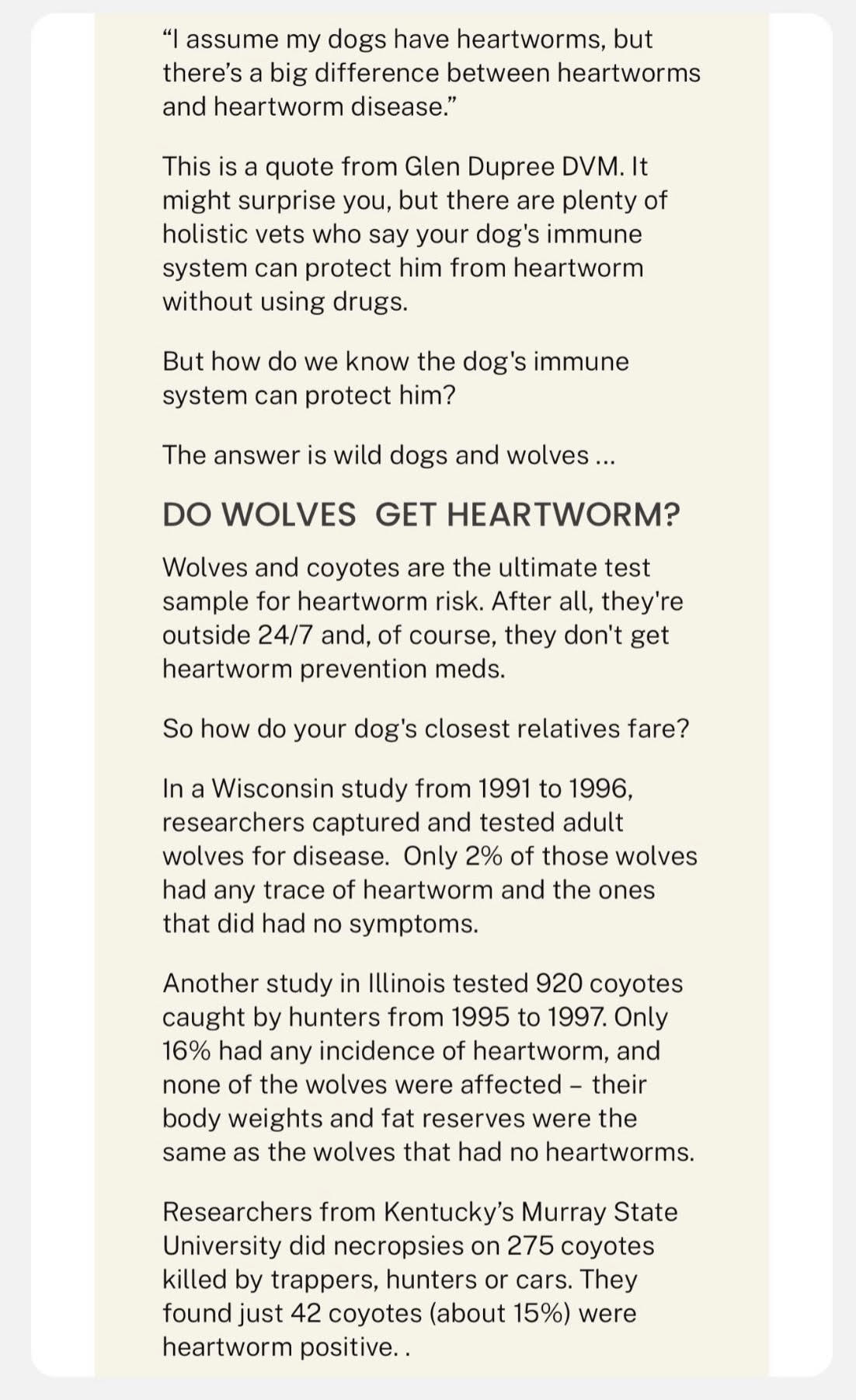
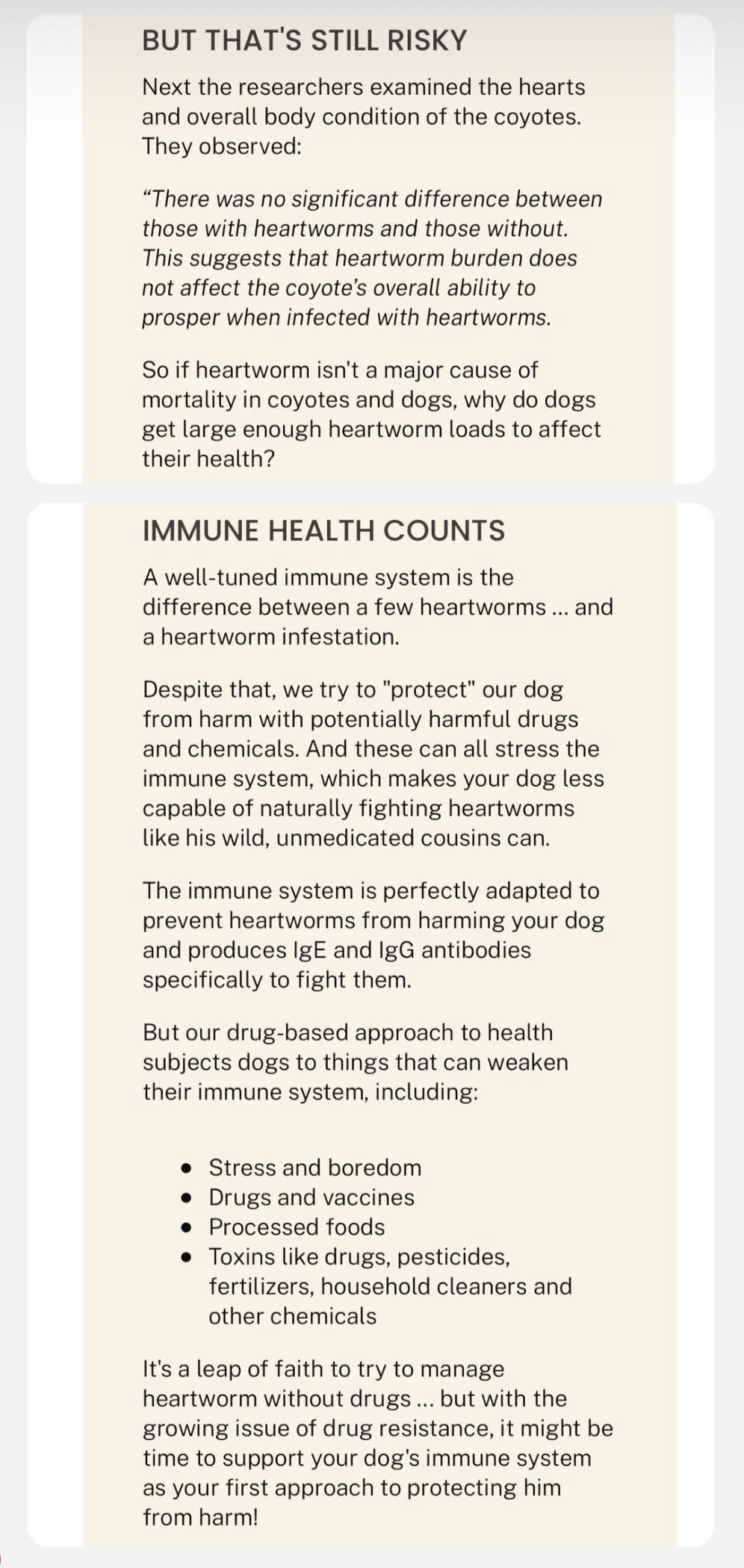
- Ozonated oil for teeth brushing. I use ozonated oil (antimicrobial – good for wounds, healing, bacteria, fungi, and pathogens) and this finger brush to brush Bear’s teeth. I do this about once per week, sometimes more/sometimes less. I’ve noticed a clear improvement in his oral health and dental plaque after regularly using this. I am almost out of hemp oil (what I’m using now). For my next purchase, I will try olive or coconut.
- Phytoplankton. For omega 3’s. I’ve also tried Nordic Naturals fish oil (sardines/anchovies) and green lipped mussels (Safe Sea). I’m not sure that he tolerated either well (he usually becomes really itchy). I’m not convinced he tolerates this one great either, but I think it may be better than the others. Side note: healthy omega levels help ward against fleas, so that’s something to consider if your pup is having trouble with fleas. Update: I stopped this and concluded Bear just doesn’t do well with any sort of fish or sea creatures.
- Desiccated fruit blend. For allergies. The blend is a combo of dried bluberries, raspberries, cranberries, and apple skins as a natural source of Quercetin.
- Bovine colostrum. Also for allergies.
- Immunity mushrooms. For immune support/allergies.
- Turkey tail mushrooms. For cancer prevention. This clip speaks to the incredible healing powers of turkey tail mushrooms.
- CBD. To help with inflammation and immune health. I worked at this company for years. They’re the best. Their farming methods are regenerative and are far higher than industry standards.
Purple ear wash:
Earlier this year, Bear had a stubborn ear infection in his right ear for over three months.
I tried…
- doing nothing and letting it naturally resolve
- homeopathy (Hepar Sulph, Pulsatilla, Sulphur, Belladonna…all separately)
- eliminating everything I feed him (including supplements) except for his beef blend
- diluted apple cider vinegar in the ear
- castor oil + neem oil in the ear (in case it was ear mites)
- witch hazel + aloe in the ear
- a natural ear wash
- a medicated ear wash
None of it worked. I considered trying mullein garlic oil in his ear next. I was looking at reviews for a product and saw someone mention “purple ear wash” and that it was the only thing that resolved their dog’s stubborn ear infection.
About two weeks into using the “purple ear wash,” Bear’s ear was restored almost entirely.
Here we are over three months later from the initial 2-week detox, and I’ve cleaned his ear maybe twice. Below is a photo of his ear the other day.

Dogs on the verge of ear canal surgery have returned to normal using this wash. With a 95-99% success rate regardless of the ear infection cause, it feels like witchcraft.
To learn about the wash, Google search “purple stuff jlsdals” (it won’t let me embed the link since it’s a PDF).
I used witch hazel instead of rubbing alcohol (some sources suggest that as a viable alternative) and a condiment bottle I had on hand.
I made the wash from scratch. These are the products I used:
If you don’t want to make the wash from scratch, you can buy a pre-made wash here.

For flea infestations:
- Flea & tick shampoo. I use this during flea infestations. It’s great for removing adult fleas/eggs. It also serves as a repellant (not for long though). I love that it has a short/gentle ingredient list.
- Earth Animal products. I tried this line (drops and yeast-free powder) to combat fleas internally when Bear had a stubborn infestation this year. I think it helped a little, but I don’t think I introduced the products slowly enough (I have little patience) and for a dog like Bear who is sensitive to many things, I don’t love giving him large amounts of potent formulas regularly (which is what you do with these products). He got diarrhea a week or so in, so I stopped. The fleas also resolved shortly after. I think these are great products so I’m keeping them on hand for future seasons and may introduce them more slowly next time. If your dog is having issues with fleas, this line may be a good place to start.
For medicinal use when we need it:
- Elbow butter. Certain breeds are prone to elbow calluses. Labs are one of them. I haven’t been good with applying this on Bear’s elbows as of late, but whenever I religiously apply it (daily or close to daily), his calluses improve. They aren’t cracking, bleeding, or problematic right now which is why they’re not on my radar. But one of them developed a bubble that bled once, and applying this to the area 2-3x per day cleared the issue up.
- Paw butter. The same company that makes the elbow butter mentioned above also makes paw butter. I think they use the same formulation (or close to it) as the elbow butter. I rarely use this on Bear because dog pads shouldn’t be too soft, but during the peaks of the seasons here (extreme heat or cold), his paws sometimes get very dry. I do a few applications when I notice his paws are dry or if they are noticeably bugging him. It seems to help.
- Massage tool. When we took Bear in for Advanced Allergy Therapeutics, I noticed that the vet used a tool similar to this one to treat the allergen. She’d send the frequency of the allergen to Bear’s body using a machine, then use the tool to hit certain acupuncture points on his body. The idea was that by hitting the acupuncture points during allergen exposure (via the frequency), his body would relax. This would then remove the stressful association his body has with the allergen. I asked her if I could just use the tool at home regularly in the same way considering he’s around environmental allergens all of the time (and therefore getting the actual frequency in real time). She seemed perplexed by my question and said it couldn’t hurt, so I use this tool on him now at home. I focus on his neck and sometimes rub it all the way down his spine. For a visual of how I do this, check my Instagram “Doggy Health” highlight.
- Snake bite kit. There are some pretty incredible testimonials on the product page relating to copperhead bites, rattlesnake bites, and dogs getting brought back from the brink of death. This is something I like to have on hand not just for Bear but for my entire family.
- Rescue Remedy. As Bear gets older, I notice he’s a bit more sensitive to sound/outdoor disturbances. This is only true if they’re close (overhead fireworks, for example, vs. fireworks in the distance, or the garbage truck). It’s not too significant, just something I’ve noticed and continue to pay attention to. I’ve only given him this concoction a handful of times and the results weren’t remarkable, but I always keep it on hand. With homeopathy, what may not be the right remedy for one situation may be the perfect remedy for another. This one is for stress relief related to travel, loud noises, and stressful events.
- HomeoPet Hot Spots. This has been great for healing sudden skin eruptions. It was key in healing the skin infection that seemed to almost kill Bear (you can find more on that in the earlier sections of this post).
- Eye drops. (see the section at the top of this post regarding Bear’s cataract)
- Other homeopathic remedies + cell salts. I have a bunch of other homeopathic remedies on hand that I’ve collected over the use. I use them on a case-by-case basis for various ailments.
- Slippery elm. Great for bowel regulation for both constipation and diarrhea.
If he has a flare-up of some sort from any of these products, I withhold everything but beef and water. After about a week of just food and mineralized water, he’s back to his perky and energetic self.
For emotional release:
A few months ago, I started using The Emotion Code to release trapped emotions from Bear. The changes were noticed almost immediately. One of the first times I treated Bear, I released “effort unreceived” from Bear (emotion was related to my husband). It’s a long story, but there is a past with that. The next day, he sat and waited by the window for my husband to come home, which he never does. In the following days, I noticed clear improvements in his vibrance and energy. He started sprinting (“pants on fire” as we call it), digging, and overall he just seemed like a happier dog. His poops improved too. After the “zing” of the first few sessions, I fell off the map, but I always think about how potent the change was and hope to start up one day again soon.
Healing the growth
I had a fire under my butt to get the growth on Bear’s paw off, so I was looking forward to getting started with the salve.
The salve I used is called Neoplasene and is derived from bloodroot, a Native American flowering herb.
It’s an awe-inspiring substance with a seeming natural intelligence. It destroys rapidly proliferating abnormal cells (cancer) and spares healthy tissue.
If you want to read up on it more, this is a fantastic write-up.
You can also do a search for success stories with Neoplasene and cancer (even internal cancers). There are plenty out there.
Under the supervision of Dr. Frick, I have been applying it to Bear’s growth. We are still in the necrosis process as I write this blog post.
I didn’t notice any drastic changes in the first day or two, but I wasn’t intentional with my application the first couple of days.
Bear wasn’t bothered by salve on day 1 or day 2, so he didn’t try to lick it off. So I just applied it and left it.
Day 3 was when Bear started to become bothered by it, so I decided to wrap it for 12 hours during the day and then let it breathe overnight. I did this on day 4 too for about 4 hours.
It is possible the salve was still working on day 1/day 2. I just noticed the most significant progress on day 3/day 4 which correlated with wrapping (which is what the directions suggest doing).
I wish I had started with the 12-hour wrap session on day 1.
Dr. Frick mentioned that once the process hits a certain point, no more salve is needed and the necrosis advances until the abnormal tissue sloughs off.
This is where we are now, on day 5. We are done with the salve application, waiting for necrosis to be complete, and actively resting and cleaning the wound.
I will post an update here when the process is complete. Below are some progress pictures.
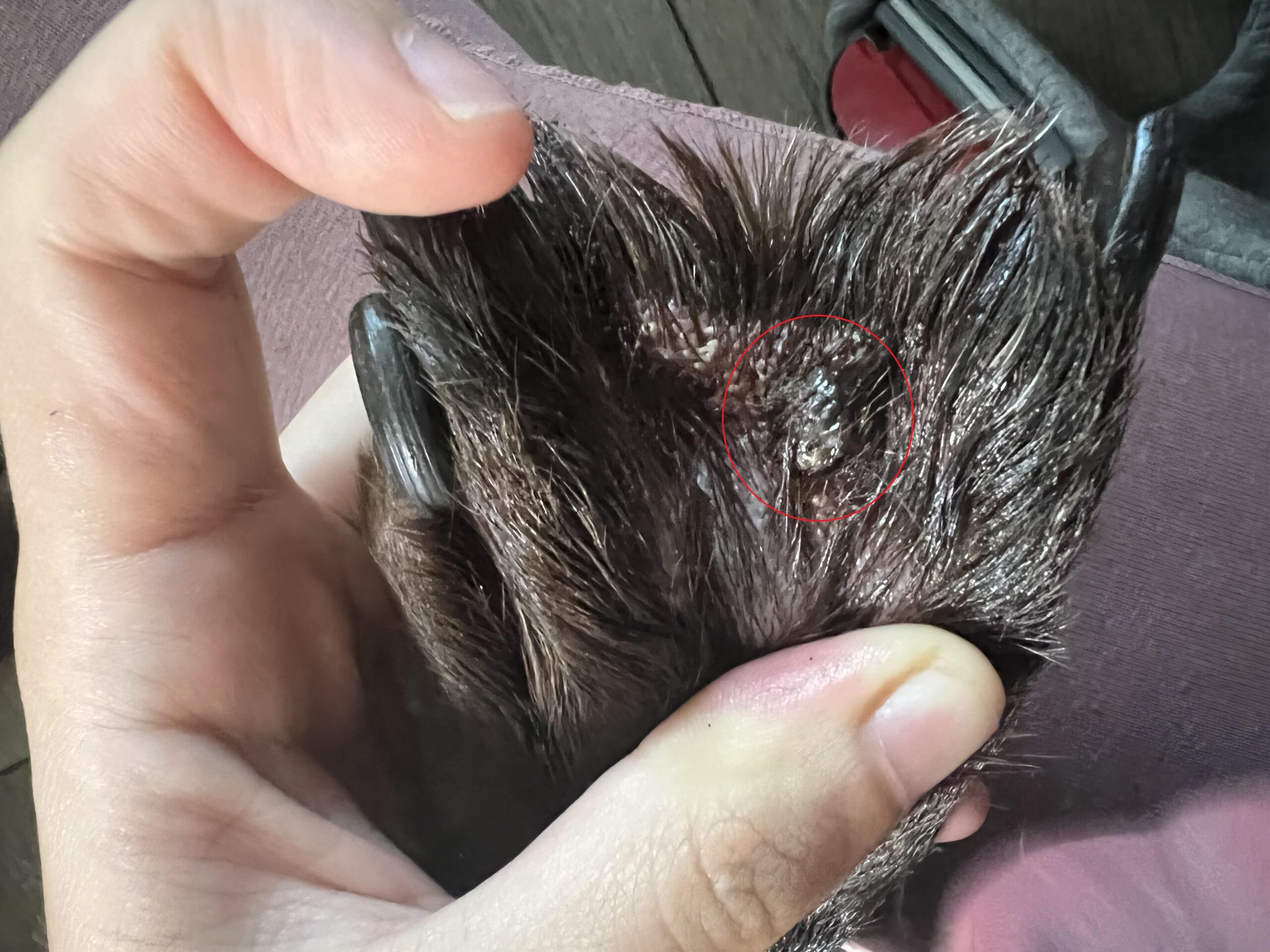
Morning day 3
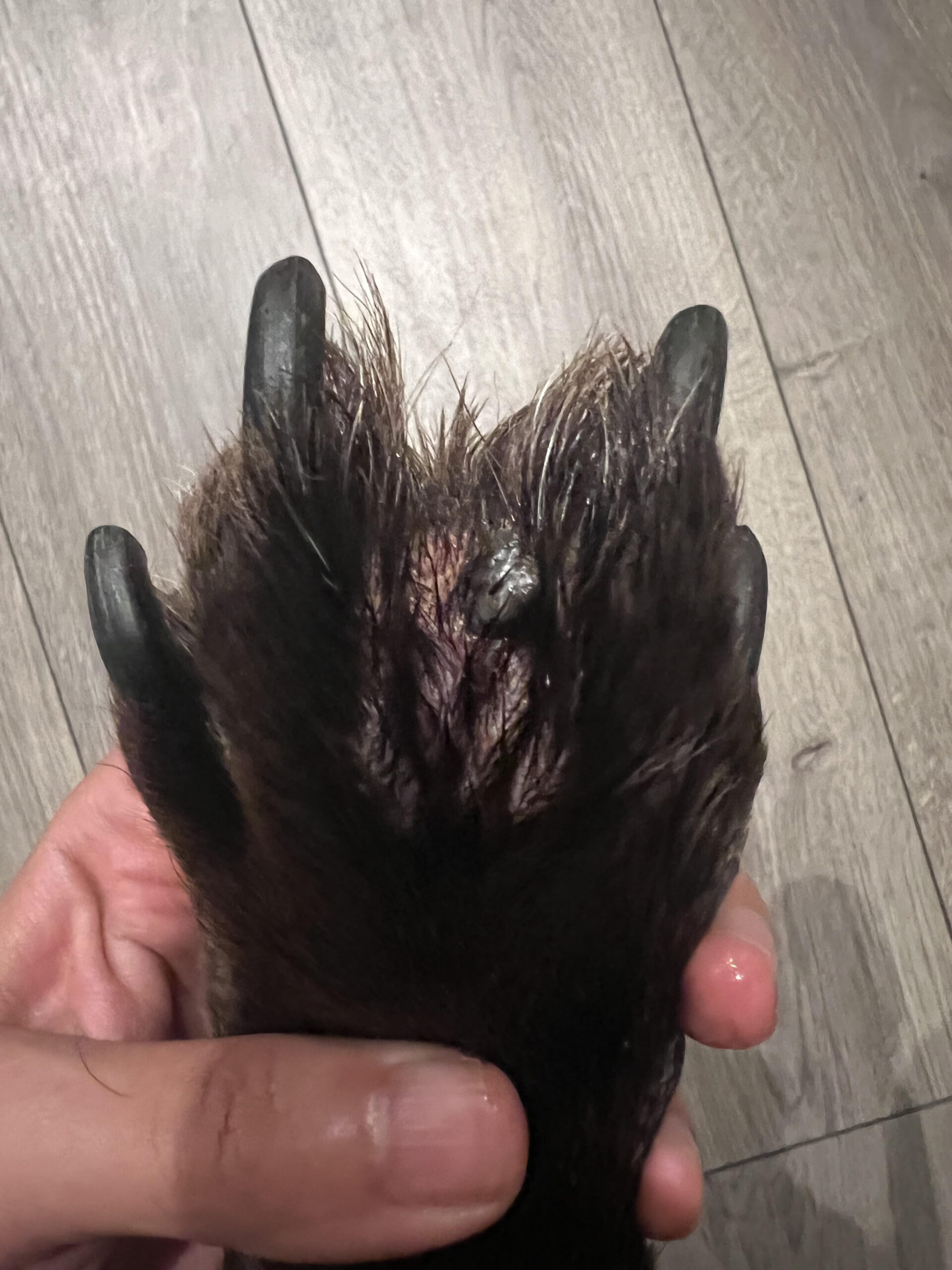
Evening day 3 (after 12 hours of wrapping). Growth began to gray
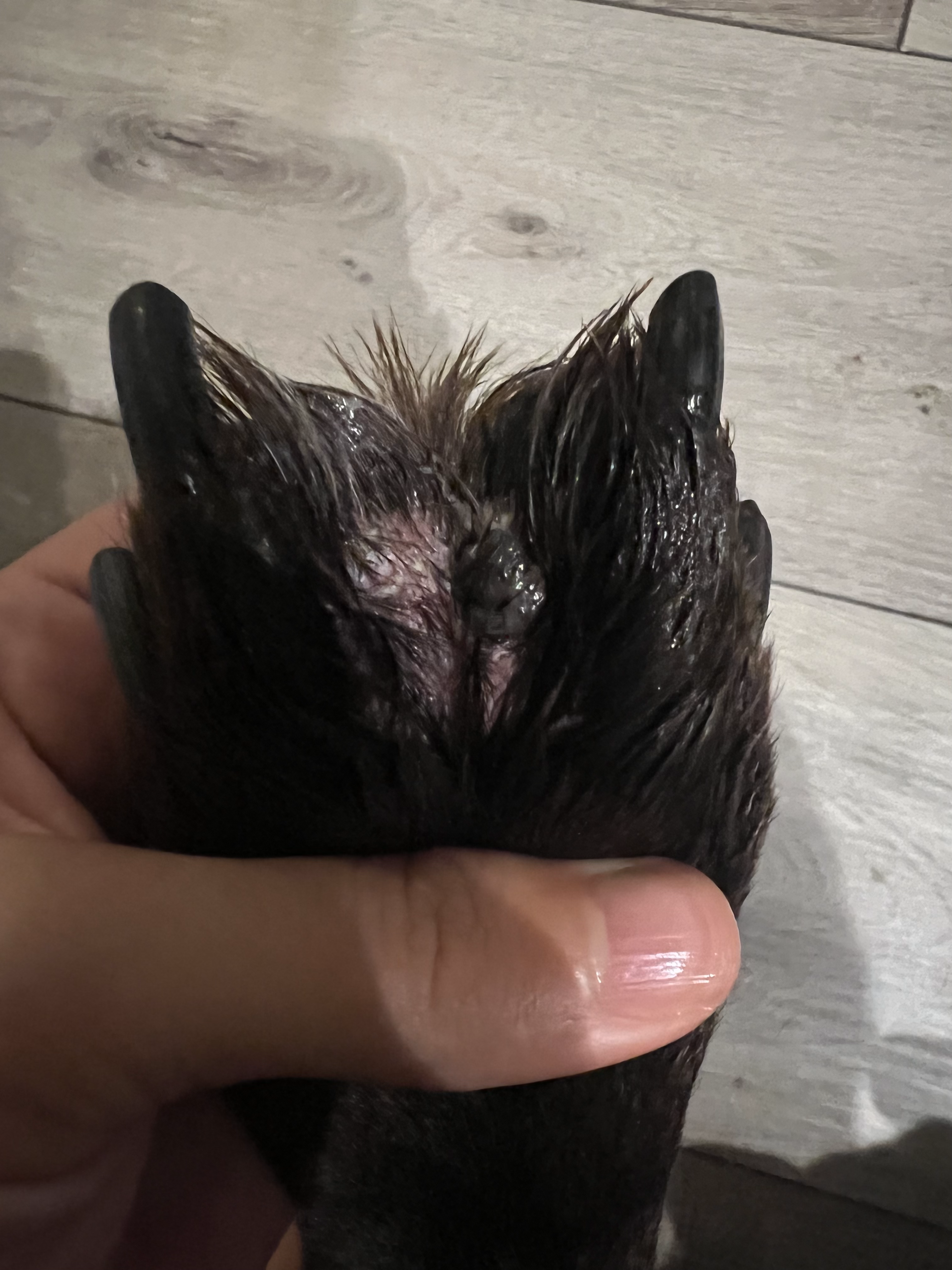
Morning day 4. Looks about the same. Growth is continuing to gray + the area around the growth is reddening (normal)

Afternoon day 4 (after 4 hours of wrapping), Growth turning white (which is good) + surrounding area starting to necrose

Morning of day 5. Beginning to rapidly necrose
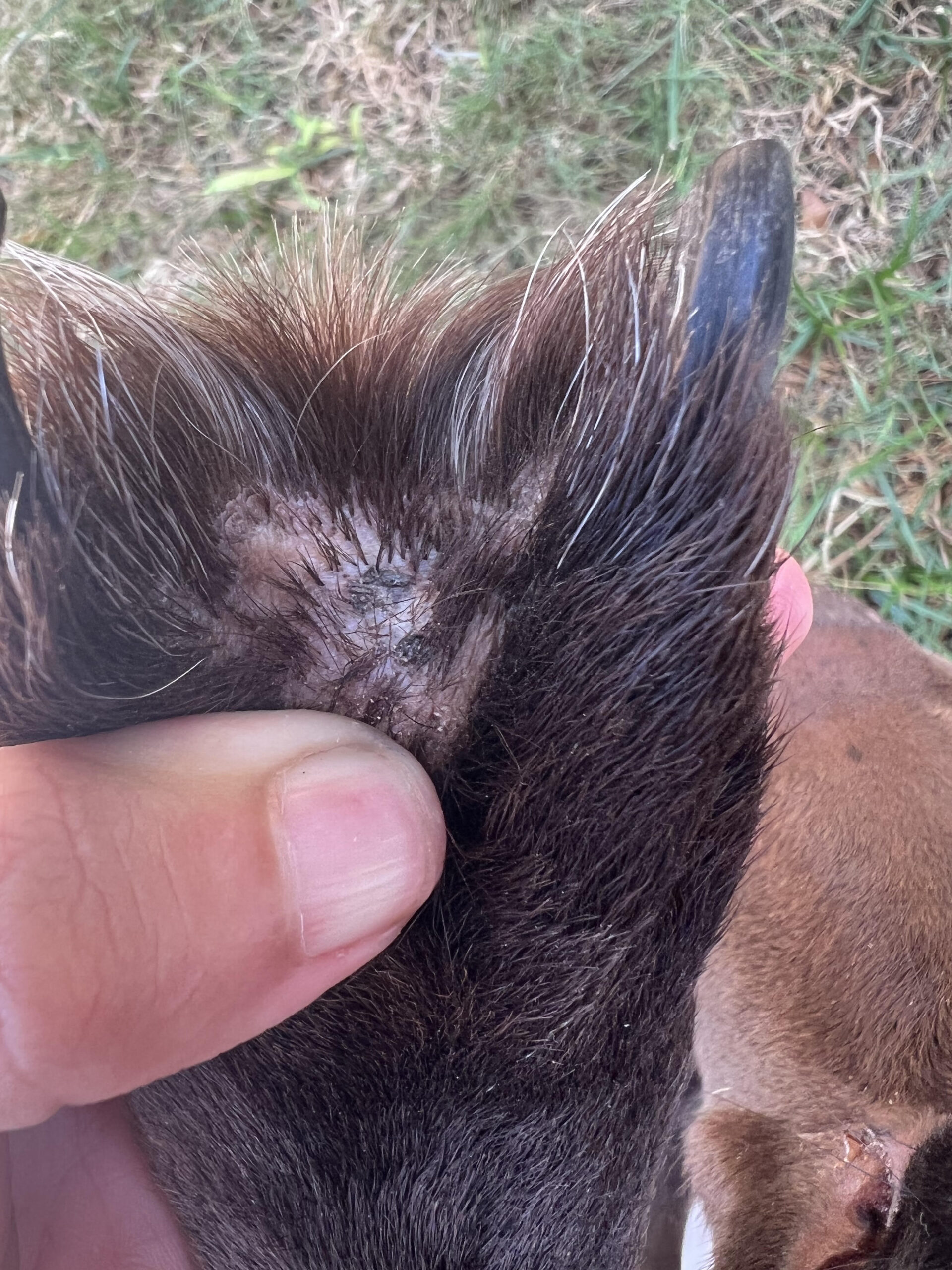
Current status. About 5 months after first application.
As you can see, there is a little bit left, but not much. The salve removed about 99% of what we could see of the growth.
The remaining bit has been hard to get. It’s a weird area – the salve usually gets pushed around once his paw closes and it never targets the small spot.
I am leaving it for now and if it starts to grow again, I may pursue injectable Neoplasene (which is the method that is often used for tumors/growths that are in hard-to-treat areas).
Overall, I am pleased with the results!
Update November 2023: The growth is starting to slowly grow back, so I am going to try 35% H2O2 topically on the growth. There are many positive anecdotes I’ve read in relation to 35% H2O2 quickly removing skin cancer, so I’m looking forward to seeing what comes of it.











